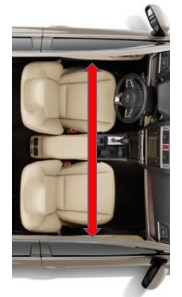RSMC Vehicle: How to validate vehicle specifications requirements
A: Cargo space
A vehicle’s cargo capacity is the space available for the RSMC to store mail items (parcels, lettermail, admail) and containers behind the front seat.
Prior to measuring the inside of the vehicle, ensure that:
• the front seat position is aligned with the door frame and in its rearmost normal driving position;
• the rear seats are folded as specified by the manufacturer; and
• the headrests are in the stowed position. The head rests are considered part of the seat.
Measure the following 3 areas as indicated in the picture.
A - The distance between the inside doors in the back passenger area.
B - The distance between the back of the driver seat to the trunk or back door seal.
C - The height measurement between the folded down seat and the top of the headrest
How to calculate the cargo capacity:
1) Record the 3 measures. If the measurements are in inches, divide them by 12 to convert to feet.
2) Multiply the 3 numbers: A x B x C to find the measurement in cubic feet.
For example:
- Measurement A = 57 inches converts to 4.75 ft.
- Measurement B = 67 inches converts to 5.58 ft.
- Measurement C = 29 inches converts to 2.42 ft.
The cubic feet calculation is: 4.45 x 5.58 x 2.42 = 60.1 cu ft.
If the vehicle type requirement is 50 cu ft., this vehicle is approved.
If the vehicle type requirement is 100 cu ft., this vehicle cargo capacity is too small.
B: Additional vehicle measurements
If the RSMC has greater than 12 and less than 250 Rural Mailboxes (RMBs) or the RSMC has a reaching tool device, the vehicle must meet the minimum interior cargo capacity as indicated on Schedule A (1) and:
- the middle of passenger window sill must be between 38” and 45” from the ground, and
-

- has a maximum interior width of 56”.

